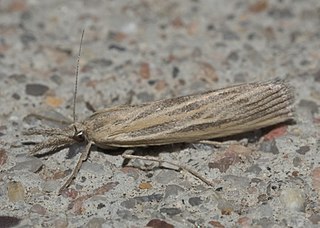
Thaumatopsis is a genus of moths of the family Crambidae.
Schinia carolinensis is a moth of the family Noctuidae first described by William Barnes and James Halliday McDunnough in 1911. It is found in the United States from eastern North Carolina to the Florida peninsula and probably along the Gulf Coast.
Coenochroa bipunctella, the sand dune panic grass moth, is a species of snout moth in the genus Coenochroa. It was described by William Barnes and James Halliday McDunnough in 1913, and is known from the United States, including Florida, Arizona and Maryland.
Macrorrhinia parvulella is a species of snout moth in the genus Macrorrhinia. It was described by William Barnes and James Halliday McDunnough in 1913 and is known from the US states of Florida and South Carolina. It is also found in Colombia.
Negalasa is a monotypic snout moth genus. Its one species, Negalasa fumalis, is found in the US state of Arizona. Both the genus and species were described by William Barnes and James Halliday McDunnough in 1913 in the same paper.
Crambidia dusca is a moth of the family Erebidae. It was described by William Barnes and James Halliday McDunnough in 1913. It is found in North America, where it has been recorded from California and Ontario.
Crambidia pura, the pure lichen moth, is a moth of the family Erebidae. It was described by William Barnes and James Halliday McDunnough in 1913. It is found in North America, including Arizona, Florida, Georgia, Kentucky, Maryland, Mississippi, New Jersey, North Carolina, Ohio, Ontario, South Carolina, Tennessee, Texas and Wisconsin.
Cisthene subrufa, the Tamaulipan lichen moth, is a moth of the family Erebidae. It was described by William Barnes and James Halliday McDunnough in 1913. It is found in the United States in Arizona and from San Benito, Texas south to Veracruz in Mexico.
Pediasia ericella is a moth in the family Crambidae. It was described by William Barnes and James Halliday McDunnough in 1918. It is found in North America, where it has been recorded from California and Alberta. The habitat consists of prairies and aspen parklands.
Thaumatopsis fieldella is a moth in the family Crambidae. It was described by William Barnes and James Halliday McDunnough in 1912. It is found in North America, where it has been recorded from California.
Microcausta flavipunctalis is a moth in the family Crambidae. It was described by William Barnes and James Halliday McDunnough in 1913. It is found in North America, where it has been recorded from Florida. It is also present in Cuba and Puerto Rico.
Xubida chiloidellus is a moth in the family Crambidae. It was described by William Barnes and James Halliday McDunnough in 1913. It is found in North America, where it has been recorded from Arizona.
Xubida punctilineella is a moth in the family Crambidae. It was described by William Barnes and James Halliday McDunnough in 1913. It is found in North America, where it has been recorded from Florida.
Glaphyria basiflavalis, the basal-dash glaphyria moth, is a moth in the family Crambidae described by William Barnes and James Halliday McDunnough in 1913. It is found in North America, where it has been recorded from Alabama, Florida, Mississippi and Texas.
Loxostege floridalis, the Christmas-berry webworm moth, is a moth in the family Crambidae. It was described by William Barnes and James Halliday McDunnough in 1913. It is found in North America, where it has been recorded from Florida and Texas.
Leptosteges flavifascialis is a moth in the family Crambidae. It was described by William Barnes and James Halliday McDunnough in 1913. It is found in North America, where it has been recorded from South Carolina to Georgia south into Florida.
Leptosteges sordidalis is a moth in the family Crambidae. It was described by William Barnes and James Halliday McDunnough in 1913. It is found in North America, where it has been recorded from Florida, Ohio, South Carolina and Ontario.
Atomopteryx solanalis, the carabid moth, is a moth in the family Crambidae. It is found in North America, where it has been recorded from Florida. The species was first described by William Barnes and James Halliday McDunnough in 1913.
Loxostegopsis merrickalis, or Merrick's pyralid moth, is a moth in the family Crambidae. It was described by William Barnes and James Halliday McDunnough in 1918. It is found in North America, where it has been recorded from Alabama, California, Florida, Georgia, Illinois, Indiana, Kansas, Maine, Manitoba, Maryland, Massachusetts, Minnesota, New Hampshire, North Carolina, North Dakota, Ohio, Ontario, Pennsylvania, Quebec, South Carolina, Texas, West Virginia and Wisconsin.
Penestola simplicialis is a moth in the family Crambidae. It was described by William Barnes and James Halliday McDunnough in 1913. It is found in Cuba and in the US state of Florida.
